Do you remember the first time you immersed yourself into a book? Of course not! You were probably just a young child exploring worlds of green eggs and ham, saying goodnight to red balloons and the moon, and rooting on that little engine that could. For most of us, we began our wonderful fiction adventures at birth with our parents at bedtime. How would you like to be a part of those special memories as an author? Perhaps you already have a story in mind but just don’t think that a children’s illustrated story is feasible with self-publishing.
I’m here to tell you it is! A recent trend we at Jera Publishing have been experiencing is the desire for authors to self-publish illustrated children’s books. With the technology of print on demand, it is possible to publish a children’s book successfully and offer it at a reasonable price. Also, with the increasing popularity of fixed-layout eBooks, you have another market to reach for your children’s story.
Once you have your story written, your first inclination may be to hire an illustrator—but wait! Before you make that important decision, you must consider the following to create a plan for your book:
Size
What size do you want your book to be? Is that size available as an industry standard through print-on-demand?
CONSIDER: If you plan on using IngramSpark/Lightning Source or CreateSpace to print and distribute, consider 8.5×8.5, 8×10, or 8.5×11
Type
What type of illustrations do you want? Are you interested in full-color or black and white? Do you want your images to be pencil drawings, watercolors, computerized drawings, or something else?
CONSIDER: Take a trip to your local book store, and look at what kind of illustrations you prefer.
Examples of illustration types:
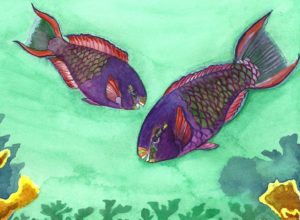
Watercolor by Claudia Makeyev. Licensed under a Creative Commons Attribution 3.0 License.
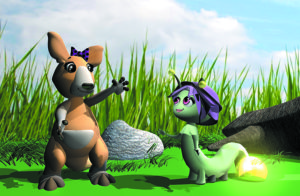
3-d computerized image from Shimmer the Glowworm Finds Her Glow by Shelby Herman, and illustrated by Natalie Kelly. Available on Amazon.
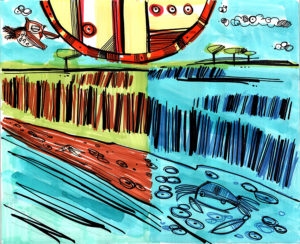
Cartoon expressionism from The Daytime Owl by Stephen Myers and illustrated by David Le Batard. Available on Amazon.
Format
Do you want the illustrations to fill a page and have the text on the facing page, to fill a double-spread with the text on top of the illustrations, or to just be small accents to the text? Do you want your illustrations to extend all the way to the edge of the page or just to the margins?
Quantity
How many illustrations do you need to aid your story?
CONSIDER: Break your story down into segments, preferably in similar length segments. Is each segment capable of having different, distinct visuals?
GOOD TO KNOW: Certain sizes are not available for print-on-demand, so before deciding, make sure the size you want is an industry standard with your on-demand printer. For options with Ingram Spark, visit www.ingramspark.com/Portal/BookTypes. For options with CreateSpace, visit www.createspace.com/Products/Book/.
TIP: If you are considering just having your children’s illustrated book as an eBook, we recommend having your illustrations prepared for print. It’s easy to take print illustrations from print to eBook form, but it’s difficult to take illustrations from eBook form to print.
Now that you have an idea of what type of illustrations you want, finding an artist to meet your requirements is the next step. The importance of illustrations in a children’s book is obvious. The pictures should jump off the page and compliment your words. Illustrations can come at a high price and make the idea of self-publishing your story just not possible. You want to make sure you hire someone who knows what they are doing without blowing your budget.
How do you find an illustrator?
- Ask friends or family if they know of someone who draws.
- Contact a local art school or college for students interested in illustration.
- Find illustrators on sites such as LinkedIn or Elance. BEWARE! Make sure you know where the illustrator resides as time zone and language barriers can cause communication issues.
- Jera Publishing has worked with various illustrators in the past. Contact us for a list of possible illustrators.
- DIY! Wait? What? DIY? Are you crazy? I can’t draw, you say. You don’t have to! Will photographs depict your story in any way? You can convert photographs into various forms of illustrations using filters in programs such as Photoshop. Jami Borek took pictures of scenes in Colonial Williamsburg and other historic sites to depict images for her book, Amanda’s Secret. Another idea for those authors with a crafting background is paper-piecing. Linda Oberlin’s books, Eco in the Garden and Barefoot Nylah, are great examples of using paper-pieced characters to portray her story.
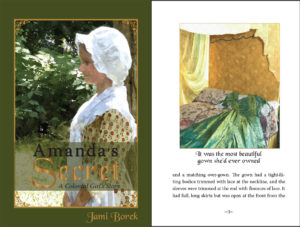
Photos to illustrations in Amanda’s Secret by Jami Borek. Available on Amazon.
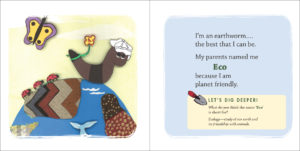
Paper-pieced illustrations in Linda Oberlin’s Eco in the Garden. Available on Amazon.
Illustration Contract
Once you find an illustrator, make sure you have a written contract outlining what is to be provided. Be sure to include the following:
- Number of illustrations.
- Cost of each illustration. Most illustrators will charge a per illustration fee.
- How will revisions be handled? Will the illustrator charge a new image fee, or are they capable of making changes for a smaller fee? This is an easier option if the illustrator uses the computer to draw instead of actual hand drawings.
- Size and print specifications. If you want your images to be in a double-page spread and fill the entire area, make sure the illustrator saves “blank space” for the text to fit into. Also, if the images are to fill a full page, your printer will require a bleed area usually of 1/8″. Make sure the illustrator has this bleed built-in to the illustration. For example, if you want to publish a book at the 8.5×8.5 size and you want each illustration to spread across two pages, the illustrator will need to draw the illustration at 8.75″ in height by 17.25″ in width. This includes the page size and bleed amount.
- Actual illustrations. How will they be provided? Will the illustrator, if using traditional methods, scan the images at a high enough resolution (at least 300 dpi at the actual size of the book plus bleeds) to be used for printing, or will they provide the drawings and you will need to have them scanned? If they use a computer to illustrate, what format will they provide the art in? If possible, we like to see illustrations in vector/eps format. However, if the illustrations are rasterized, we prefer a TIFF file. JPEGs are acceptable but can lose quality.
- Will you pay a deposit and then pay the remaining balance upon receipt of the images?
- How long will it take for the illustrations to be completed?
TIP: If you plan on using illustrations that fill a double-page spread, be sure your illustrator is aware of the “gutter” or the inside of the book where the binding will be. It’s important that essential elements of an illustration are outside of this area to prevent from being cut in half in a funny way by the gutter. Also, if the illustration is building in “blank space” for the text, it’s important the blank areas be within the margins and outside of the gutter.
Sound too confusing? Let Jera Publishing assist you in the process of working with an illustrator. We can work with them to make sure that what they provide for your book is the right size, the right resolution, and the right format, leaving you headache free! Already have illustrations but not sure whether or not they are suitable for print? Send a few to us for review, and we can offer suggestions as for which book size and format will work best for your illustrations.
CASE STUDY: We recently completed a book for Stephen Myers, a first-time author that was referred to us by Jamie Wolfe, author of Start Over! Stephen came to us with his story and illustrations completed. He just needed assistance in laying out the story with the artwork, creating a cover, and converting to eBook files. The illustrations are amazing! The problem? The dimensions of the artwork did not scale well into an industry-standard size for print-on-demand. Also, there wasn’t much “blank space” for the text. We worked with Stephen to come up with a solution turning the beautiful illustrations and story into a paperback, hardcover and eBook formats. Below are images of the layout progressions we went through to come up with the final layout style.
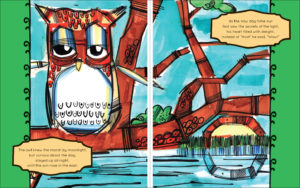
Sample 2 – 8.5×11 with full illustrations across two-page spread (with background) and text in frames.
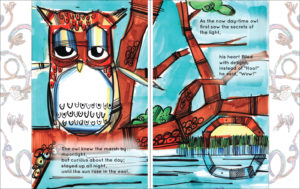
Final – 8.5×11 with full illustrations across two-page spread (with faded border pulled from one of the illusrtations) and text in “blank space” with a cloud effect applied behind text.
Once you have your illustrations done, it’s time to layout the text with the words and create your cover. That’s where we come in! We will take your text and illustrations and provide different concepts for you to choose from. Once you have approved a concept, we will prepare your full book. Upon approval, we can turn your book into a fixed-layout eBook that you can offer for sale on Apple’s iBooks store and Amazon’s Kindle store.
For printing, you may choose to offer both a hardcover and a paperback. If you want to offer a hardback version, we recommend using IngramSpark/Lightning Source (IS/LSI). They offer four different options for printing in color that vary in quality of printing and paper stock. If you only want a softcover, consider either IS/LSI or CreateSpace. If you are on a tight budget, you can consider using CreateSpace where they provide you an ISBN and do not charge a title set-up fee.
Are you ready to self-publishing your children’s illustrated book? View children’s books we have done in our portfolio, or check out our children’s illustrated book design service. We also offer a complete children’s illustrated book package that includes the interior layout, cover design, and fixed-layout eBook for $425.


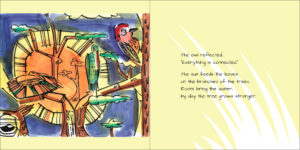
Hello,
I have a full color 32 page 1500 word children’s book that I want to POD with Ingramspark. What would you ballpark estimate be for layout, typset, and make ready for Ingram.
Thanks for your time and attention
I’m working on a chapter book with fourteen illustrations. I have illustrated a number of full color book but am not up todate with the POD my client wants to use. I have worked in pen and ink for black and white but am not sure of gray scales images. I would think gray scale is as expensive as color since they would use 256 shades of gray. I am looking at a number of chapter books now that must be using digital screening to create the gray. I would prefer to go digital but don’t want to get half done only to find I should of used straight black and white.
You are fine with the grayscale. Black/white printing is actually grayscale. To produce the gray, it’s just black ink screened based on the percentage of black the gray is. Its the same process as your home printer when printing a document using just black ink.
Good stuff Stephanie, thanks for all that and looking forward to working with you!
You say “if you want to publish a book at the 8.5×8.5 size and you want the each illustration to spread across two pages, the illustrator will need to draw the illustration at 8.75″ in height by 19.25″ in width.”.
Why is the width 19.25?
You want the width to be 19.25 to accomodate a bleed on the left outer edge (0.125) and right outer edge (0.125):
0.125″ (bleed) + 8.5″ (left page) + 8.5″ (right page) + 0.125″ (bleed) = 19.25″
If the illustration is just going on one page, then the width would be 8.625″:
0.125″ (bleed) + 8.5″ (page) = 8.625″
You will also need a bleed on the top and bottom. The only place a bleed is not required is on the inside margin.
It seems with those 4 numbers you quote above, the total would only be 17.25″, not 19.25″.
Yes! You are correct. Thank you for the correction. I appreciate it! I’ve updated the article to reflect the proper math. Just goes to show you, no matter how many times an article (or book!) has been reviewed, even by professional editors, mistakes can slip through.